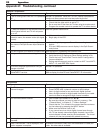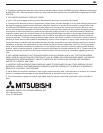
Appendices 115 Appendices 115
IEEE 1394 Devices
Symptom Remarks
1. Excessive digital artifacts appear when
viewing an IEEE 1394 device.
• The IEEE 1394 cable is too long; 15 feet between devices is
the maximum.
• There may be a slow device in the middle of the IEEE 1394
network. Move the slow devices to the end so that connec-
tions for faster devices do not pass through them.
2. D-VHS recordings for digital cable have
drop-outs (loss of picture or sound), or no
playback.
Digital cable signals on IEEE 1394 can exceed the data rate stan
-
dards supported by DVCR.
IEEE 1394 Recording
Symptom Remarks
1. Program to be recorded was correctly
selected from ChannelView, however, incor
-
rect program was recorded.
The broadcaster supplied program information that was incorrect
and/or was changed after a recording was added to the Record
List.
2. Incomplete ChannelView program recorded. Recording device may lack sufficient blank space to make a full
recording.
3. ChannelView program recording failed. • Connection and compatibility issues with IEEE 1394
(FireWire®) digital devices. This may include too many
Firewire devices in use at one time, or the recording device
not understanding the record command.
• Television lost power long enough to lose current clock time.
• Analog VCR power was left off.
• TV energy Mode was set to Low Power. Change TV Energy
mode to Fast Power On. Press MENU, open the Setup menu,
highlight the Fast Power On radio button, press ENTER.
4. Cannot record to or from the IEEE 1394
device, including dubbed recordings.
• To initiate a recording to IEEE 1394 device, press the
(RECORD) key. The Record menu displays allowing setup of
the recording.
• The source device for the recording is not powered on.
• When dubbing, the destination device for the recording is not
powered on.
• The wrong medium (analog tape for digital recording, or
digital tape for the analog recording) is in the device.
• The program is copy protected.
• The program has already been recorded once and the copy
protection only allows one recording.
• Unapproved source device for copy protected material.
• The recording device can not decode the copyright signal
included in the signal source (try another device if available).
• The playing device (for dubbing) does not support copy-
righted material.
• Source for recording is copyrighted
• Too many IEEE 1394 devices in network. Insufficient band-
width available. Disconnect unused devices.
• Source Device has higher communication speed (S 400) than
record device. If possible, reverse devices, play in the slower
device and record in the faster device.
Appendix E: Troubleshooting, continued


















